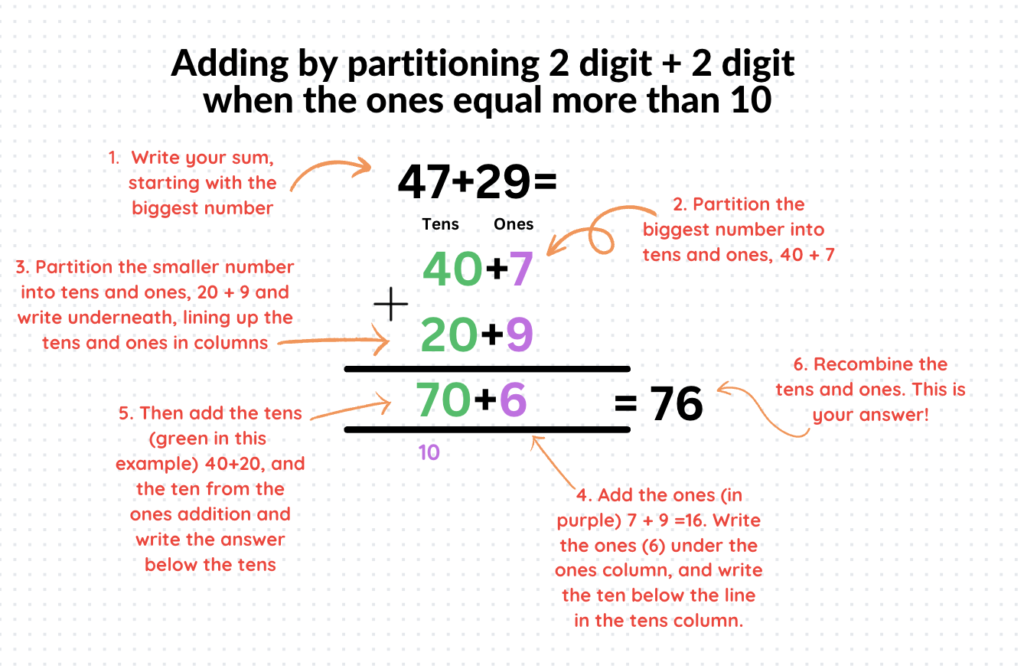The methods that children use for addition may well baffle parents at first glance, and have you wondering what on earth their teachers and maths tutors are getting your children to do! The methods for teaching written methods to younger children in Guernsey primary schools have evolved over time as a result of advances in research in maths education and children’s cognitive development. These methods aim to help children better understand the underlying concepts of addition and subtraction, by learning a series of progressive steps, rather than going straight to the formal written method, which teachers and maths tutors in Guernsey will tell you is too abstract for young children to easily understand.
One of the key differences in the way written methods are taught today is a shift towards more visual and concrete representation. For instance, rather than simply committing a series of number facts (although there is of course still a place for this), children are taught to think of numbers of groups of objects, pictures or even equipment such as Dienes (hundreds blocks, tens sticks, and ones mini cubes). Children can then visualise, manipulate and rearrange numbers to solve problems.
Another vital concept is that of place value, which underpins our whole number system. Children must have a good understanding of the terms tens and ones, and how they are represented in a written number before using the methods below, as many of these methods rely on this concept.
Let’s take a look at the progression of written methods for addition, alongside some of the visual aids used to help children understand what the problems are asking them to do. There may be some slight variation between Guernsey schools, but if you are unsure, you could ask your child’s school for a copy of their calculations policy, which will outline the progression. It is important to remember that different methods will resonate with different children and so our Guernsey maths tutors encourage children to use the method that works best for them at any given point in time (which might mean ‘skipping’ one of the progressions).
Numberlines
Numberlines are a method of encouraging children to visualise the relationship between numbers and their position on a continuum of numbers. This supports the understanding of number and place value. Counting and skip counting forwards and backwards also helps with fluency of counting, understanding of patterns and development of basic adding skills.

For the following method, it is important that your child has a good understanding of what it means to partition (split) a number into tens and ones – this is something our Guernsey maths tutors often help younger students to understand.

Generally speaking, by the time children are ready to work using 3 digit numbers, they have good enough conceptual understanding to move on to a more advanced step on the addition written methods continuum. However, for some children, the familiarity of a numberline can support learning how to add three digit numbers. Your child’s teacher, or one of our Guernsey maths tutors, will be able to recommend which method is best for them right now.

Partitioning
Once children have established the visual of a numberline in their minds, and have a reasonable understanding of place value, they can move towards the partitioning method, firstly supported by equipment or drawings, and then alone.



Other methods of representing addition problems
Most Guernsey primary schools (as well as our Guernsey maths tutors) make good use of the Singapore bar model and part/part whole models as a way of representing arithmetic problems. Whilst these methods for addition don’t allow you to solve the problem, it gives a strong visual representation of what the problem requires your child to do.

Last image here – Bar 3 dig smallPNG
What does this all equal?
Once your child has mastered these progressive methods, they will then be ready to begin to use the standard column method algorithm for addition, and have a really good concrete and visual understanding. They will be ready to work with and solve problems in a more abstract way, using a method which can be adapted to bigger numbers, decimals and even negative numbers too.
Look out for our guides to subtraction, multiplication and division written methods, coming soon!












